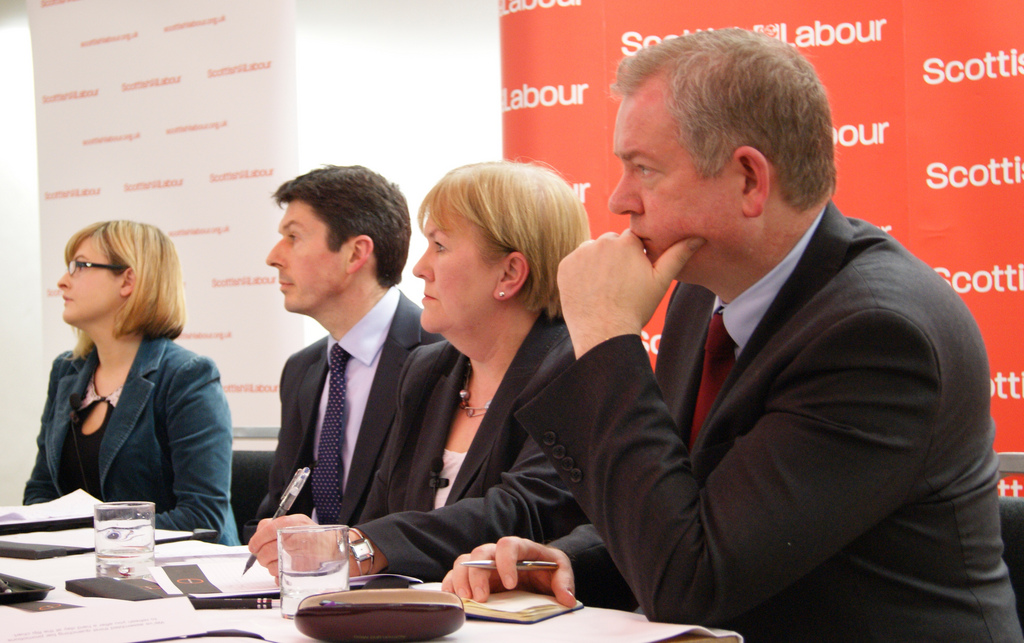The time may have come for the creation of “all-men shortlists”
All-women shortlists have been a controversial but effective way of increasing the percentage of women in Parliament. However, its adoption also creates de-facto all-men lists, with strong male candidates coalescing around the non-all women seats. Rainbow Murray argues that the time has come to formalise the arrangements, with ‘all men’ and ‘all women’ seats being distributed evenly to create a situation where there is an equal distribution of seats between the sexes, without the obligation for women to feature on the shortlists of seats they are unlikely to win.

Should mixed-gender selection races become a thing of the past? (Credit: Scottish Labour, CC by 2.0)
It is now two decades since the Labour party introduced All-Women Shortlists (AWS) in an attempt to redress the serious gender imbalance within the parliamentary party. These shortlists have been controversial, but relatively successful in their goal of increasing women’s representation. They are the main reason why the percentage of women in Westminster doubled overnight after the 1997 election, even though the policy was temporarily scrapped in 1996 following a legal challenge. (It was reintroduced in 2002 after a change in legislation; the percentage of women in parliament actually dropped in 2001, demonstrating how much the parties have struggled to increase women’s representation without the use of mechanisms such as AWS).
Other parties have contemplated following Labour’s lead, but have hesitated for a mixture of pragmatic and ideological reasons. David Cameron preferred the “A-list”, with mixed results, while the Liberal Democrats openly rejected the idea of AWS. However, women who once proudly sported t-shirts saying “I am not a token woman” have since changed their minds. Jo Swinson, for example, has acknowledged that 147 out of 237 districts in 2009 had an all-men shortlist for the Liberal Democrats. Although AWS have been contested on the grounds that they are unmeritocratic and unfair to men, the evidence suggests that parties do not incur a penalty for their use and they are widely acknowledged as being the most effective means of increasing women’s representation. It is no coincidence that more than half of the women sitting in Westminster are on the opposition benches, even though Labour have a minority of MPs in parliament.
So why on earth am I advocating all-men shortlists? The reason is simple. They already exist in practice, and the failure to acknowledge this properly creates a host of problems that could be resolved by labelling them explicitly as constituencies for men.
At present, the Labour party has two kinds of seat: “open” seats, and AWS. Where a “favourite son” wishes to stand, the party will avoid ring-fencing the seat for a woman. AWS constituencies are those where there is a favoured female candidate, and/or there is no strongly favoured male candidate. Given the high levels of competition for winnable seats, it is a struggle to find enough seats without male incumbents or favourite sons that can be reserved for women; as a result, almost every remaining “open” seat is in fact effectively ring-fenced for a man. No women have won nomination in an “open” target seat since the last election. This is not because women are not competitive, but because strong women candidates are given AWS districts, while open seats are considered seats for men in all but name.
As long as women are still getting selected via AWS, you might ask what the problem is. The answer is threefold. Firstly, labelling seats for women as AWS and seats for men as open is stigmatising to women. It suggests that women are less competitive candidates and can only win in constituencies reserved for them, whereas men can win anywhere. This denies the reality that many “open” seats are effectively stitched up for men. If open seats are renamed “all-men shortlists”, both men and women are selected on single-sex lists, with no claims of special treatment, inferior status or discrimination on either side.
This brings us to the second issue – currently open seats are not all-men shortlists, even though men almost exclusively win them. In fact, there is an obligation to ensure that there is at least one woman on the shortlist. This is not a good thing if it means forcing a token woman to contest the seat, at considerable personal expense, only to endure the humiliation of losing. If these seats are not truly open – and I argue that they are not – then there is no point in maintaining the charade of having women on the shortlist. Better to recognise that these are seats for men, label them as such, and spare good women from having to maintain a facade of gender equality that only serves to reinforce false beliefs that women are uncompetitive.
If gender equality is truly to be achieved, treating men and women on equal terms is necessary. Renaming open seats as all-men shortlists (AMS) removes the differential terms for men’s and women’s selection, but leaves open the third issue, namely that AWS currently comprise less than half of all constituencies. If seats become split into AWS and AMS, it then becomes rather more difficult to justify having fewer than half of the seats for women. Anything less than a 50:50 split would reveal rather transparently the ongoing inequalities in candidate selection. Replacing open seats with AMS would therefore serve as a trigger for dividing seats equally between AWS and AMS. If the seats are divided appropriately – with each sex receiving an equal proportion of safe, target and unwinnable seats – this would be a huge boon for gender equality and for women’s representation.
The idea of reserving half of each type of seat for women and half for men is not new, in theory or practice. Known as “twinning” – with seats paired in terms of winnability, one reserved for a woman and the other for a man – this concept has been applied successfully in elections to the Welsh Assembly, and is one of the reasons why women’s representation is so much higher there than in Westminster. AMS would therefore not be a giant leap into unchartered territory for the Labour party (and for any other party that wished to follow suit). What AMS would do is remove the stigma of AWS, promote an equal distribution of seats between the sexes, and remove the humiliating obligation for women to feature on the shortlists of seats they stand no realistic chance of winning. The first step towards ending discriminatory practices is to recognise that they exist.
—
Note: this post originally appeared on the PSA blog under the title ‘Time for All-Male Shortlists?‘ and is re-posted with permission. Please read our comments policy before posting. The shortened URL for this post is: https://buff.ly/1eGckx4
—
 Rainbow Murray is Reader in Politics at Queen Mary University of London. Her books include Parties, Gender Quotas and Candidate Selection in France and Cracking the Highest Glass Ceiling: A Global Comparison of Women’s Campaigns for Executive Office. She has published widely in journals such as Party Politics, Political Research Quarterly, West European Politics andPolitics & Gender, and she is an editor of the EJPR Political Data Yearbook. Her article on ‘Quotas for Men’ has been conditionally accepted by the American Political Science Review. She tweets @RainbowMurray.
Rainbow Murray is Reader in Politics at Queen Mary University of London. Her books include Parties, Gender Quotas and Candidate Selection in France and Cracking the Highest Glass Ceiling: A Global Comparison of Women’s Campaigns for Executive Office. She has published widely in journals such as Party Politics, Political Research Quarterly, West European Politics andPolitics & Gender, and she is an editor of the EJPR Political Data Yearbook. Her article on ‘Quotas for Men’ has been conditionally accepted by the American Political Science Review. She tweets @RainbowMurray.





 Democratic Audit's core funding is provided by the Joseph Rowntree Charitable Trust. Additional funding is provided by the London School of Economics.
Democratic Audit's core funding is provided by the Joseph Rowntree Charitable Trust. Additional funding is provided by the London School of Economics.
“No women have won nomination in an “open” target seat since the last election. ”
In the meantime some women won from open shortlists: Brent Central, Finchley, Gloucester, Brentford and Sherwood
oh god “@democraticaudit: Time for “all-men shortlists”? https://t.co/3PGNc86wQM“
Time for “all-men shortlists”? https://t.co/CUR2ETjZyx
If we had a proper electoral system we could spend a lot less time talking about AWS and boundaries https://t.co/0juqQBHBGN
MT @democraticaudit: Time may have come for the creation of “all-men” & “all-women” shortlists says @RainbowMurray https://t.co/fcxZ29hk2W
The time may have come for the creation of “all-men shortlists” argues @RainbowMurray https://t.co/rQFCoQp3Gl
The time may have come for the creation of “all-men shortlists” https://t.co/Jftu7fJ6h2
The time may have come for the creation of “all-men shortlists”, says Rainbow Murray. https://t.co/hi5KtVUFyl
New on DA today: The time may have come for the creation of “all-men shortlists” by Rainbow Murray https://t.co/Nzk7L6tsHl
Interesting RT @democraticaudit: The time may have come for the creation of “all-men shortlists” https://t.co/R4nYHgMx85
The time may have come for the creation of “all-men shortlists” https://t.co/kg2kpPilBZ